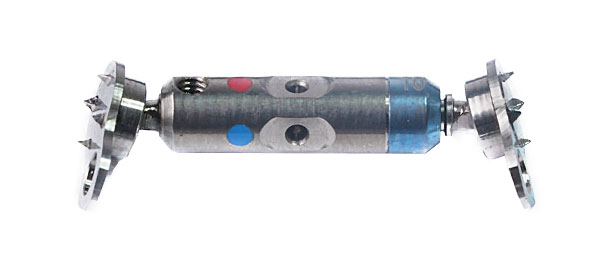UNI-Smile Distractor
Most commonly used type

Palatal distraction is used to correct cross bites and to restore a natural occlusion. The technique is called Surgically Assisted Rapid Palatal Expansion (SARPE) or Surgically Assisted Rapid Maxillary Expansion (SARME).
Transpalatal distraction (TPD), based on the distraction osteogenesis phenomenon, is used for correcting transverse maxillary deficiency by increasing the maxillary bone base, and therefore the transverse maxillary dimension.
The smile distractors are bone-born devices that are easy to apply and to remove by the surgeon, easy to activate twice a day by the patient and easy to be monitored by a professional. Patients also report great satisfaction on the distractor, due to oral comfort and oral hygiene it offers.
Advantages
- Smallest module on the market
- Easy to activate by the patient
- Excellent oral comfort and hygiene
- Plates are self-adjusting to the bone surface
- Small pins for an additional grip on the bone
What should you tell your patient?
- He should see the opening between the 2 front teeth getting larger every day.
- The smile distractor needs to be cleaned daily by your patient using a soft child toothbrush.
- In case the distractor becomes loose during the healing process, he needs to contact you to re-tighten or remove it.
Please check out our patient information below!
View our publications.
Catalogue
Surgical Procedures
Patient information
Case studies
Videos
Publications
- 2020 - BioMed Research International
Dental and Skeletal Changes after Transpalatal Distraction - 2018 - Journal of Cranio-Maxillo-Facial Surgery
Bone changes on lateral cephalograms and CBCT during treatment of maxillary narrowing using palatal osteodistraction with bone-anchored appliances - 2017 - Journal of Cranio-Maxillofacial Surgery
The effects of surgically assisted rapid maxillary expansion (SARME) on the dental show and chin projection. - 2017 - Journal of Oral and Maxillofacial Surgery
Following Surgically Assisted Rapid Palatal Expansion, Do Tooth-Borne or Bone- Borne Appliances Provide More Skeletal Expansion and Dental Expansion? - 2015 - Journal of Cranio-Maxillofacial Surgery
Surgical management of cross-bites in orthognathic surgery: Surgically assisted rapid maxillary expansion (SARME) versus two-piece maxilla - 2015 - Journal of Cranio-Maxillofacial Surgery
One-stage tooth-borne distraction versus two stage bone-borne distraction in surgically assisted maxillary expansion (SARME). - 2015 - Polish Annals of Medicine
Changes in transverse tooth and bone dimensions during transversal maxillary hypoplasia treatment by maxillary distraction osteogenesis using a device installed on a bone - 2014 - Journal of Cranio-Maxillo-Facial Surgery
Transpalatal distraction - State of the art for the individual management of transverse maxillary deficiency - A review of 50 consecutive cases. - 2022 - Journal of Oral and Maxillofacial Surgery
Do sex and age influence nasal soft tissue widening after bone-borne transpalatal distraction?

